These Shanghai Noodles are a Chinese stir-fried noodle dish that boasts the perfect blend of fresh noodles, fragrant ginger, and succulent pork, crafting a culinary masterpiece you won’t soon forget. It’s full of flavor and easy to make in just 20 minutes that’s sure to satisfy your craving for authentic Chinese cuisine.
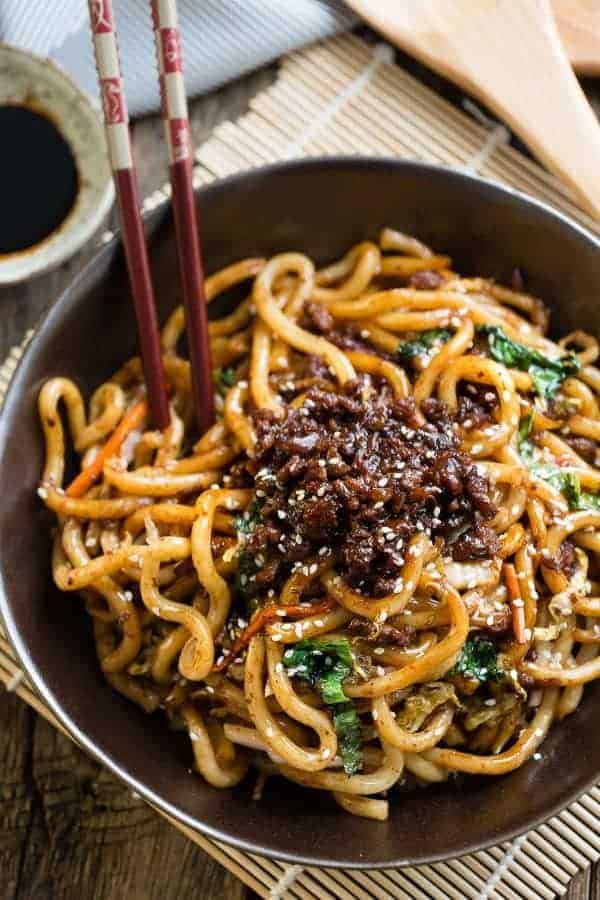
Mastering Shanghai Noodles: A Delectable Recipe Guide
When it comes to savory, satisfying, and quick Asian-inspired dishes, Shanghai Noodles are a standout favorite. This stir-fried noodle recipe combines tender fresh Shanghai-style noodles with lean ground pork (or your preferred protein), fresh vegetables tossed in a flavorful savory sauce. The melding of flavors in this delectable dish, from the umami-rich sauce to the zesty ginger and garlic, makes it a true culinary masterpiece.
Shanghai Fried Noodles are an easy, delicious, and versatile dish that can be customized to your liking. Whether you enjoy them with a fiery kick or prefer a milder flavor, this recipe provides the flexibility to suit your palate with gluten-free and low carb options creating a delightful dish that’s perfect for weeknight dinners or casual gatherings.
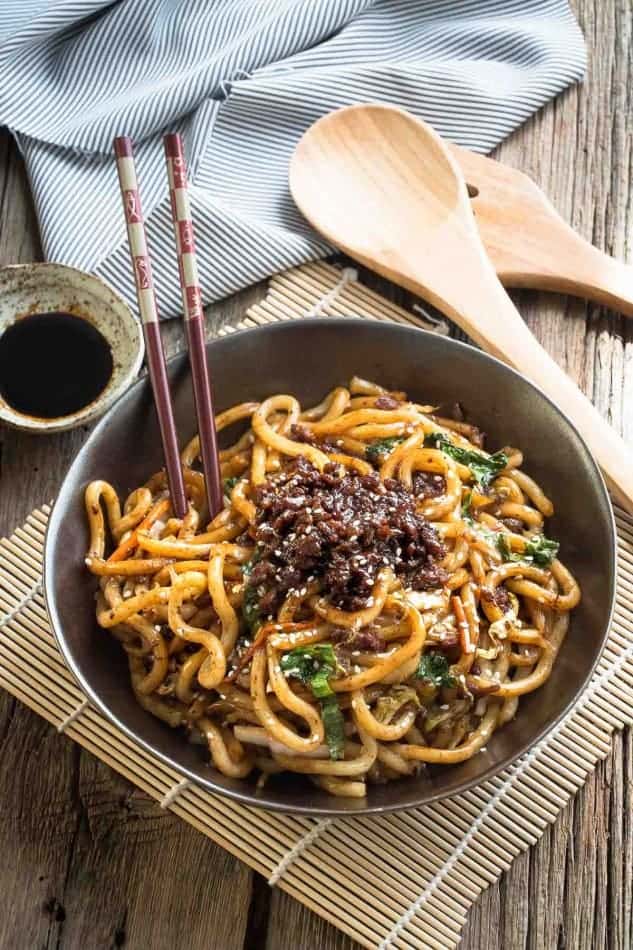
What are Shanghai Noodles?
Cu Chao Mian, also known as “Chao Mian” or “ShanghaiStir-Fried Noodles – 上海粗炒面” is a beloved Chinese dish with a rich history that mirrors the country’s culinary traditions. With its fragrant aromas, mouthwatering flavors, and versatile ingredient combinations, Shanghai Noodles are a staple in Chinese cuisine that you can usually find it at most dumpling houses there but have also gained popularity worldwide
The Origin of Cu Chao Mian
Cu Chao Mian’s history is deeply rooted in Chinese culinary traditions, with a focus on stir-frying, noodles, and the use of aromatic ingredients. While it’s challenging to pinpoint the exact origin of the dish, stir-frying has been a cooking method in Chinese cuisine for thousands of years, dating back to the Shang dynasty (16th-11th centuries BC).
Ingredients You’ll Need
- Lean Ground Pork: This ingredient forms the protein base of the dish. You can easily substitute it with ground chicken or another preferred protein.
- Fresh Shanghai-Style Noodles: The star of the show, these fresh noodles offer a chewy, satisfying texture. If unavailable, you can use udon or cooked gluten-free fettuccine noodles.
- Salt and Black Pepper: Essential for seasoning the pork and giving it a flavorful kick.
- Fresh Ginger and Garlic: These aromatic ingredients add depth and richness to the sauce, infusing it with a warm and zesty character.
- Thinly Shredded Napa Cabbage: The cabbage not only provides a hint of freshness but also contributes to the dish’s overall texture and body.
- Green Onion: Thinly sliced for a mild, oniony bite, green onions lend a pop of color and freshness to the final dish.
- Sesame Seeds: A delightful garnish, sesame seeds add a lovely nutty crunch and visual appeal to your Shanghai Noodles.
The Flavorful Sauce
- Water: As a base for the sauce, water helps to balance and distribute the other ingredients evenly.
- Low Sodium Soy Sauce: Adds that characteristic salty umami flavor. For a healthier alternative, you can substitute with coconut aminos or gluten-free tamari.
- Toasted Sesame Oil: Provides a deep, toasty aroma that elevates the overall flavor profile.
- Oyster Sauce: This savory ingredient infuses the dish with richness. If you’re looking for a vegan alternative, try the Vegan Oyster Sauce from Naked & Saucy.
- Dark Soy Sauce: Apart from adding color, it imparts a caramelized layer of flavor. If you can’t find it, replace it with more light soy sauce or a suitable alternative.
- Chinese Cooking Wine or Dry Sherry: For an additional layer of flavor. You can omit it if you prefer an alcohol-free version.
- Brown Sugar: Adds a touch of sweetness. You can replace it with a lower-sugar option like coconut sugar, golden monk fruit sweetener, or your favorite brown sugar substitute.
- Ground White Pepper: A milder alternative to black pepper, it complements the other flavors perfectly.
- Cornstarch: This thickening agent creates the perfect consistency for the sauce. If you’re corn-free, feel free to substitute with tapioca starch, arrowroot starch, or potato starch.
- Sriracha Sauce or Red Pepper Flakes (Optional): If you enjoy a little heat, this is where you can add some spicy kick to your Shanghai Noodles.

Instructions: How to make Shanghai Noodles
- Season the Pork: Begin by seasoning the lean ground pork with salt and black pepper in a medium bowl.
- Prepare the Sauce: In another medium bowl, whisk together all the sauce ingredients, including water, soy sauce, sesame oil, oyster sauce, dark soy sauce (if using), wine, sugar, pepper, cornstarch, and Sriracha. Set it aside for later.

- Sauté the Pork: Heat cooking oil in a wok or heavy skillet over medium-high heat. Add the seasoned pork, and crumble it while breaking up any large lumps.
- Infuse with Aromatics: Add the finely minced garlic and grated ginger to the pork, continuing to cook until the meat is no longer pink, which usually takes about 5 minutes.
- Incorporate Cabbage: Stir in the thinly shredded Napa cabbage and stir-fry it until it’s tender.

- Add Noodles and Sauce: Now, add the fresh Shanghai-style noodles, breaking them up if necessary. Pour the prepared sauce over the noodles, tossing to combine and coat everything with the rich, flavorful sauce. Adjust seasonings as needed and add Sriracha or red pepper chili flakes if you desire extra heat.

- Garnish and Serve: Once the noodles are well-coated, remove the dish from heat and garnish it with sesame seeds for a delightful finishing touch.
Tips for Success
- To make the noodles easier to work with, blanch them in boiling water for a minute before stir-frying.
- Customize the heat level by adjusting the Sriracha or red pepper flakes to your preference.
- Prep all your ingredients ahead of time (mise en place) for a smooth and efficient cooking process.
Serving Suggestions
These noodles shine as a standalone dish, but you can also serve them with:
- Steamed or stir-fried bok choy or Chinese Broccoli (Gai Lan)
- A side of kimchi or pickled vegetables
- With a bowl of instant pot rice or Easy Fried Rice
- A light salad for added freshness
- A drizzle of extra soy sauce or sesame oil for extra flavor
Variations and Substitutions
- Vegetarian: Skip the pork and load up on your favorite veggies like mushrooms, bell peppers, and snap peas.
- Spicy Lovers: Add extra Sriracha or red pepper flakes for intense heat. You can also add more or less chili oil, chili flakes, or even Sichuan peppercorns to control the heat. The level of heat in Cu Chao Mian can be easily tailored to suit your taste buds.
- Gluten-Free: Choose gluten-free soy sauce, tamari, and noodles for a celiac-friendly version.
- Vegan: Cu Chao Mian can easily be adapted for vegetarians and vegans by omitting animal-based proteins and using plant-based substitutes. Tofu, tempeh, or seitan are great protein options, and vegan oyster sauce can replace the traditional version.
- Low-Carb: Substitute the noodles with hearts of palm noodles, low carb pasta noodles, spiralized zucchini or shirataki noodles for a lighter version.
Storage and Freezer Instructions
Shanghai Noodles are best enjoyed fresh, but if you have leftovers, store them in an airtight container in the refrigerator for up to 2 days. Reheat them gently in a pan or the microwave.
For longer-term storage, Shanghai Noodles can be frozen in an airtight container for up to 3 months. When ready to enjoy, defrost in the refrigerator and reheat by stir-frying or microwaving.

Frequently Asked Questions (FAQ’s)
1. What are the key ingredients used in Cu Chao Mian?
Cu Chao Mian typically consists of fresh noodles, vegetables, and a protein source such as pork, chicken, or tofu. The dish is flavored with a sauce that includes ingredients like soy sauce, oyster sauce, sesame oil, and various seasonings to create its distinctive taste.
2. Are there regional variations of Cu Chao Mian?
Yes, there are many regional variations of Cu Chao Mian. For instance, in Shanghai, you might find Cu Chao Mian with a slightly sweet and dark soy-based sauce. In Sichuan, it’s known for its fiery spiciness due to the use of Sichuan peppercorns and chili oil. Each region puts its own spin on the dish to suit local tastes.
3. What are some common variations or toppings for Cu Chao Mian?
Cu Chao Mian is incredibly versatile, and you can personalize it with a variety of toppings and additions. Some popular choices include green onions, bean sprouts, mushrooms, bok choy, and even a fried or soft-boiled egg.
4. What makes Cu Chao Mian so popular?
The popularity of Cu Chao Mian is primarily due to its delightful combination of flavors and textures. It’s a versatile dish that appeals to a wide range of tastes, and it’s quick and easy to prepare, making it a favorite for busy individuals and families.
5. Where can you buy Shanghai Noodles?
You can buy Shanghai-Style Noodles at most Asian markets near the refrigerated section or even online.
6. What are Shanghai Noodles made of?
Shanghai egg noodles are typically made with mostly wheat flour and eggs.
More Chinese noodle recipes you will love:
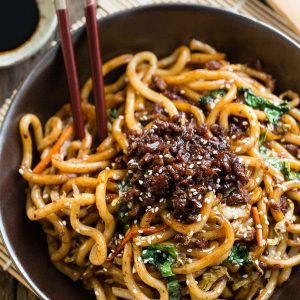
These Shanghai Fried Noodles are a Chinese stir-fried noodle dish that boasts the perfect blend of fresh noodles, fragrant ginger, and succulent pork, crafting a culinary masterpiece you won't soon forget. It's full of flavor and easy to make in just 20 minutes that's sure to satisfy your craving for authentic Chinese cuisine.
- 1/2 - 3/4 lb lean ground pork , feel free to sub with ground chicken or ground protein of choice if preferred
- 1 lb fresh Shanghai-style noodles (484 grams) , you can also substitute with udon or cooked gluten-free fettuccine noodles if you can't find the fresh noodles
- 1/4 tsp salt
- ¼ tsp black pepper
- 1 ½ tbsp fresh ginger , grated or minced
- 2 garlic cloves , finely minced
- 2/3 cups thinly shredded Napa cabbage
- 1 green onion , thinly sliced
- sesame seeds , for garnish
- 2 tablespoons water
- 1 1/2 tablespoons low sodium soy sauce , you can substitute with coconut aminos or gluten-free tamari if you're soy-free
- 1/2 tablespoon toasted sesame oil
- 1/2 tablespoon oyster sauce , if you can't use traditional oyster sauce, you can try subbing with this Vegan Oyster Sauce from Naked & Saucy
- 3 teaspoons dark soy sauce* , adds color and a caramelized layer of flavor but you can sub with more light soy sauce or coconut aminos or gluten-free tamari if you can't find dark soy sauce
- 2 teaspoons Chinese cooking wine or dry sherry , adds another layer of flavor dimension but you can omit if you prefer not to use alcohol
- 1 teaspoon brown sugar , you can also substitute with coconut sugar, golden monk fruit sweetener, brown Swerve or brown sugar substitute of choice for a lower sugar option
- 1/8 teaspoon ground white pepper
- 1 tablespoon cornstarch , you can also sub wit tapioca starch, arrowroot starch or potato starch if you're corn-free
- ¼ teaspoon Sriracha sauce , hot sauce of choice or red pepper flakes , to taste (optional)
- In a medium bowl, season pork with salt and pepper.
- In a separate medium bowl, whisk together all the ingredients for the sauce - water, soy sauce, sesame oil, oyster sauce, dark soy sauce (if using), wine, sugar, pepper, corn starch and Sriracha. Set aside.
- Heat cooking oil in a wok or heavy skillet over medium-high heat. Add pork, and crumble while breaking up large lumps.
- Add garlic and ginger and continue cooking until meat is no longer pink, about 5 minutes.
- Mix in cabbage and stir-fry until tender.
- Add in noodles, breaking up strands if necessary and pour sauce on top. Toss to combine, coating with sauce. Adjust seasonings as needed and add Sriracha or red pepper chili flakes, for some heat, if desired.
- Remove from heat and garnish with sesame seeds.
- If you can't find dark soy sauce, replace with 3 teaspoons soy sauce instead.
*If you can't find dark soy sauce, replace with 3 teaspoons soy sauce instead.
How to store
Shanghai Noodles are best enjoyed fresh, but if you have leftovers, store them in an airtight container in the refrigerator for up to 2 days. Reheat them gently in a pan or the microwave.
How to freeze:
For longer-term storage, Shanghai Noodles can be frozen in an airtight container for up to 3 months. When ready to enjoy, defrost in the refrigerator and reheat by stir-frying or microwaving.



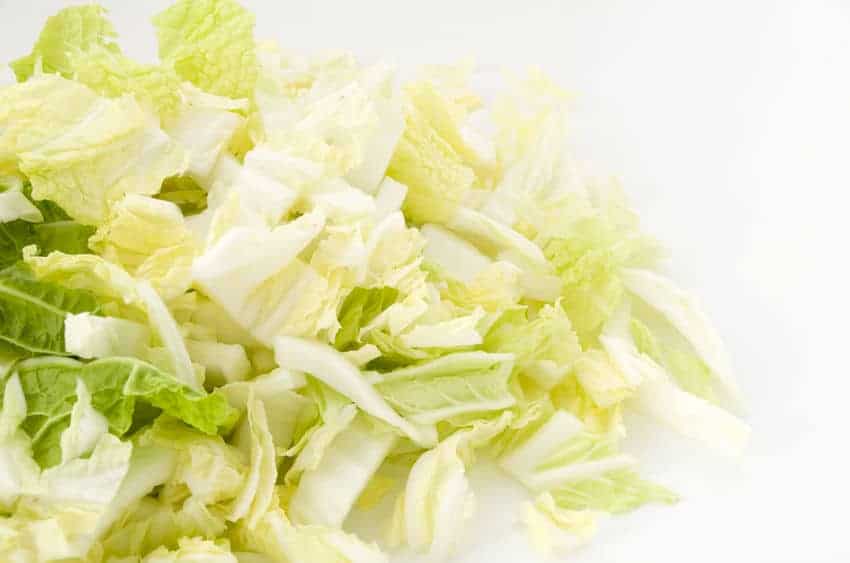
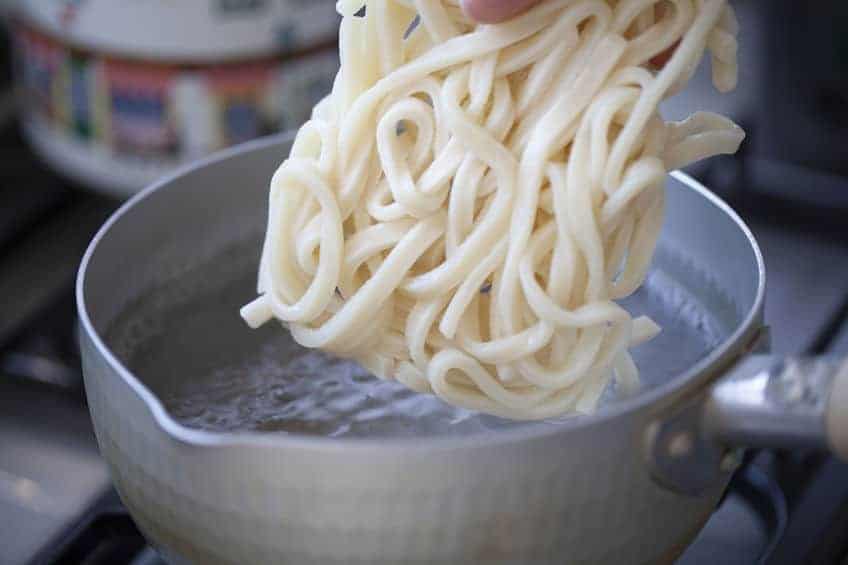
 Did you try this recipe?
Did you try this recipe?






Jessica Spanswick -
Delicious recipe! Made to as close as possible. Used Chuka soba noodles and only light soy sauce since it was all I had on hand but still turned out amazing. Added some red peppers as well for a touch of extra veggies. Definitely want to try with the proper noodles and will add peas next time too.
Anne -
I used chicken, baby bok choy and broccoli. Followed recipe as written. Delicious! That sauce spot on! Thank you for fabulous recipe.
Eileen -
This was so good! My family has never had this and now it’s a regular. Thank you!
JEnnifer M -
Great recipe. Made a vegan version of it tOnight, substituting meAt with vegetaBles, and using vegan Oyster sauce etc. Delicious, quick, and family friendly. Everyone devoured it.
Jade Ballard -
Great recipe!!! As a college student it’s a delicious quick and easy recipe 🙂